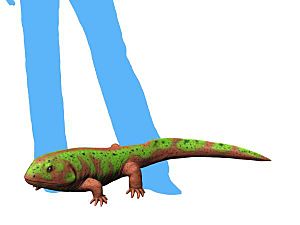Pederpes facts for kids
Quick facts for kids Pederpes |
|
|---|---|
 |
|
| Scientific classification | |
| Species | |
|
Pederpes finneyae Clack, 2002 (type) |
Pederpes ("Peter's Foot") was an extinct animal that lived a very long time ago. It was an early tetrapod, which means it was one of the first four-legged animals. Pederpes lived about 348 to 347.6 million years ago, during a time called the Tournaisian age, which is part of the early Carboniferous period.
This ancient creature had only one known species, called Pederpes finneyae. It was about 1 meter (3 feet) long. Pederpes was one of the earliest tetrapods from the Carboniferous period. It had a big, somewhat triangle-shaped head, a bit like its relative Whatcheeria. Pederpes was different from Whatcheeria because of small differences in its bones, like a special spike on its arm bone where a muscle attached. Its feet were different from the paddle-like feet of older animals like Ichthyostegalia from the Devonian period. Instead, its feet looked more like those of later Carboniferous animals that lived on land. Pederpes is the earliest known tetrapod to show signs of walking on land. Even though it might have had a sixth toe on its front feet, it mostly used five toes to move around.
Contents
Discovering Pederpes
Pederpes was first found in 1971 in central Scotland. When it was first discovered, scientists thought it was a type of lobe-finned fish. Its fossils were found in a rock layer called the Ballagan Formation. The main fossil, known as the type specimen, was a nearly complete skeleton. Only its tail and a few bones from its head and limbs were missing.
It wasn't until 2002 that a scientist named Jennifer Clack studied the fossil again. She realized it was not a fish but a very early tetrapod. She then officially named it Pederpes.
Where Pederpes Fits in the Animal Family Tree
Pederpes belongs to a family of animals called Whatcheeriidae. Scientists are still working to understand how this family is related to other tetrapod families. While Pederpes is considered an amphibian in a general sense, it is not part of the group that includes modern amphibians like frogs and salamanders. Because it is a very early and basic tetrapod, it is placed in the traditional class Amphibia in the old way of classifying animals, called Linnaean taxonomy.
Pederpes is a very important fossil because it comes from a time period known as Romer's gap. This was a time when there were very few fossils of land animals. Finding Pederpes gives scientists rare and valuable information about how tetrapods developed during a period when life on land was still uncommon.
The fossil was found in rocks from the Ballagan Formation, which are about 348 to 347.6 million years old.
How Pederpes Lived
Pederpes was about 1 meter (3 feet) long, which was an average size for early tetrapods.
The shape of its skull and the way its feet pointed forward (instead of out to the sides) suggest that Pederpes was well-suited for living on land. It is currently the earliest known animal that could walk fully on land. However, its ears were still much better at hearing underwater than on land. This means Pederpes might have spent a lot of its time in the water and could have hunted there too.
Its narrow skull suggests that Pederpes breathed by using muscles to pull air into its lungs. This is similar to how most modern tetrapods breathe. It was different from how many modern amphibians breathe, which often use a throat pouch to pump air into their lungs.
Images for kids
See also
 In Spanish: Pederpes para niños
In Spanish: Pederpes para niños



